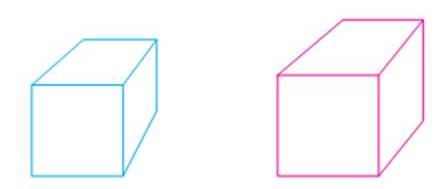
EP USING+UNDERSTANDING MATH.-MYMATHLAB
6th Edition
ISBN: 9780321922205
Author: Bennett
Publisher: PEARSON CO
expand_more
expand_more
format_list_bulleted
Textbook Question
Chapter 11.B, Problem 16E
Correct Perspective. Consider the two boxes shown in Figure 11.31. Which one is drawn with proper perspective relative to a single vanishing point? Explain.

FIGURE 11.31
Expert Solution & Answer
Want to see the full answer?
Check out a sample textbook solution
Students have asked these similar questions
Page <
1
of 2
-
ZOOM +
1) a) Find a matrix P such that PT AP orthogonally diagonalizes the following matrix
A.
= [{² 1]
A =
b) Verify that PT AP gives the correct diagonal form.
2
01
-2
3
2) Given the following matrices A =
-1
0
1] an
and B =
0
1
-3
2
find the following matrices:
a) (AB) b) (BA)T
3) Find the inverse of the following matrix A using Gauss-Jordan elimination or
adjoint of the matrix and check the correctness of your answer (Hint: AA¯¹ = I).
[1 1 1
A = 3 5 4
L3 6 5
4) Solve the following system of linear equations using any one of Cramer's Rule,
Gaussian Elimination, Gauss-Jordan Elimination or Inverse Matrix methods and
check the correctness of your answer.
4x-y-z=1
2x + 2y + 3z = 10
5x-2y-2z = -1
5) a) Describe the zero vector and the additive inverse of a vector in the vector
space, M3,3.
b) Determine if the following set S is a subspace of M3,3 with the standard
operations. Show all appropriate supporting work.
13) Let U = {j, k, l, m, n, o, p} be the universal set. Let V = {m, o,p), W = {l,o, k}, and X = {j,k). List the elements of
the following sets and the cardinal number of each set.
a) W° and n(W)
b) (VUW) and n((V U W)')
c) VUWUX and n(V U W UX)
d) vnWnX and n(V WnX)
9) Use the Venn Diagram given below to determine the number elements in each of the following sets.
a) n(A).
b) n(A° UBC).
U
B
oh
a
k
gy
ท
W
z r
e t
་
C
Chapter 11 Solutions
EP USING+UNDERSTANDING MATH.-MYMATHLAB
Ch. 11.A - Prob. 1QQCh. 11.A - Prob. 2QQCh. 11.A - Prob. 3QQCh. 11.A - Prob. 4QQCh. 11.A - Prob. 5QQCh. 11.A - Prob. 6QQCh. 11.A - Prob. 7QQCh. 11.A - Prob. 8QQCh. 11.A - Prob. 9QQCh. 11.A - Prob. 10QQ
Ch. 11.A - Prob. 1ECh. 11.A - 2. Define fundamental frequency, harmonic, and...Ch. 11.A - 3. What is a 12-tone scale? How are the...Ch. 11.A - 4. Explain how the notes of the scale are...Ch. 11.A - Prob. 5ECh. 11.A - Prob. 6ECh. 11.A - Prob. 7ECh. 11.A - Prob. 8ECh. 11.A - Prob. 9ECh. 11.A - Prob. 10ECh. 11.A - Prob. 11ECh. 11.A - Prob. 12ECh. 11.A - Octaves. Starting with a tone having a frequency...Ch. 11.A - Notes of a Scale. Find the frequencies of the 12...Ch. 11.A - Prob. 15ECh. 11.A - 16. The Dilemma of Temperament. Start at middle A,...Ch. 11.A - Exponential Growth and Scales. Starting at middle...Ch. 11.A - 18. Exponential Growth and Scales. Starting at...Ch. 11.A - 19. Exponential Decay and Scales. What is the...Ch. 11.A - Prob. 20ECh. 11.A - Prob. 21ECh. 11.A - Prob. 22ECh. 11.A - Mathematics and Music. Visit a website devoted to...Ch. 11.A - Mathematics and Composers. Many musical composers,...Ch. 11.A - Prob. 25ECh. 11.A - Prob. 26ECh. 11.A - Digital Processing. A variety of apps and software...Ch. 11.A - Prob. 28ECh. 11.B - Prob. 1QQCh. 11.B - 2. All lines that are parallel in a real scene...Ch. 11.B - 3. The Last Supper in Figure 11.6. Which of the...Ch. 11.B - Prob. 4QQCh. 11.B - Prob. 5QQCh. 11.B - Prob. 6QQCh. 11.B - Prob. 7QQCh. 11.B - Prob. 8QQCh. 11.B - Prob. 9QQCh. 11.B - Prob. 10QQCh. 11.B - Prob. 1ECh. 11.B - Prob. 2ECh. 11.B - Prob. 3ECh. 11.B - Prob. 4ECh. 11.B - Prob. 5ECh. 11.B - 6. Briefly explain why there are only three...Ch. 11.B - 7. Briefly explain why more tilings are possible...Ch. 11.B - 8. What is the difference between periodic and...Ch. 11.B - Prob. 9ECh. 11.B - Prob. 10ECh. 11.B - Prob. 11ECh. 11.B - Prob. 12ECh. 11.B - Prob. 13ECh. 11.B - Prob. 14ECh. 11.B - Vanishing Points. Consider the simple drawing of a...Ch. 11.B - Correct Perspective. Consider the two boxes shown...Ch. 11.B - Drawing with Perspective. Make the square, circle,...Ch. 11.B - Drawing MATH with Perspective. Make the letters M,...Ch. 11.B - 19. The drawing in Figure 11.34 shows two poles...Ch. 11.B - Two Vanishing Points. Figure 11.35 shows a road...Ch. 11.B - Prob. 21ECh. 11.B - Prob. 22ECh. 11.B - Prob. 23ECh. 11.B - Prob. 24ECh. 11.B - Prob. 25ECh. 11.B - Prob. 26ECh. 11.B - Prob. 27ECh. 11.B - Prob. 28ECh. 11.B - Prob. 29ECh. 11.B - Prob. 30ECh. 11.B - 30-31 : Tilings from Translating and Reflecting...Ch. 11.B - 32-33: Tilings from Quadrilaterals. Make a tiling...Ch. 11.B - Tilings from Quadrilaterals. Make a tiling from...Ch. 11.B - Prob. 34ECh. 11.B - Prob. 35ECh. 11.B - Prob. 36ECh. 11.B - Prob. 37ECh. 11.B - Prob. 38ECh. 11.B - Art and Mathematics. Visit a website devoted to...Ch. 11.B - 40. Art Museums. Choose an art museum, and study...Ch. 11.B - Prob. 41ECh. 11.B - Penrose Tilings. Learn more about the nature and...Ch. 11.B - Prob. 43ECh. 11.C - Prob. 1QQCh. 11.C - 2. Which of the following is not a characteristic...Ch. 11.C - 3. If a 1-foot line segment is divided according...Ch. 11.C - 4. To make a golden rectangle, you should
a. a...Ch. 11.C - Prob. 5QQCh. 11.C - Prob. 6QQCh. 11.C - Suppose you start with a golden rectangle and cut...Ch. 11.C - Prob. 8QQCh. 11.C - Prob. 9QQCh. 11.C - Prob. 10QQCh. 11.C - Prob. 1ECh. 11.C - How is a golden rectangle formed?Ch. 11.C - What evidence suggests that the golden ratio and...Ch. 11.C - Prob. 4ECh. 11.C - 5. What is the Fibonacci sequence?
Ch. 11.C - 6. What is the connection between the Fibonacci...Ch. 11.C - 7. Maria cut her 4-foot walking stick into two...Ch. 11.C - Prob. 8ECh. 11.C - Prob. 9ECh. 11.C - Prob. 10ECh. 11.C - Prob. 11ECh. 11.C - Prob. 12ECh. 11.C - Prob. 13ECh. 11.C - Prob. 14ECh. 11.C - Prob. 15ECh. 11.C - Prob. 16ECh. 11.C - Prob. 17ECh. 11.C - 18. Everyday Golden Rectangles. Find at least...Ch. 11.C - 19. Finding . The property that defines the golden...Ch. 11.C - 20. Properties of
a. Enter into your calculator....Ch. 11.C - Prob. 21ECh. 11.C - The Lucas Sequence. A sequence called the Lucas...Ch. 11.C - Prob. 23ECh. 11.C - The Golden Navel. An Old theory claims that, on...Ch. 11.C - Prob. 25ECh. 11.C - Prob. 26ECh. 11.C - Prob. 27ECh. 11.C - Prob. 28ECh. 11.C - Golden Controversies. Many websites are devoted to...Ch. 11.C - 30. Fibonacci Numbers. Learn more about Fibonacci...
Knowledge Booster
Learn more about
Need a deep-dive on the concept behind this application? Look no further. Learn more about this topic, subject and related others by exploring similar questions and additional content below.Similar questions
- 10) Find n(K) given that n(T) = 7,n(KT) = 5,n(KUT) = 13.arrow_forward7) Use the Venn Diagram below to determine the sets A, B, and U. A = B = U = Blue Orange white Yellow Black Pink Purple green Grey brown Uarrow_forward8. For x>_1, the continuous function g is decreasing and positive. A portion of the graph of g is shown above. For n>_1, the nth term of the series summation from n=1 to infinity a_n is defined by a_n=g(n). If intergral 1 to infinity g(x)dx converges to 8, which of the following could be true? A) summation n=1 to infinity a_n = 6. B) summation n=1 to infinity a_n =8. C) summation n=1 to infinity a_n = 10. D) summation n=1 to infinity a_n diverges.arrow_forward
- 1) Use the roster method to list the elements of the set consisting of: a) All positive multiples of 3 that are less than 20. b) Nothing (An empty set).arrow_forward2) Let M = {all postive integers), N = {0,1,2,3... 100), 0= {100,200,300,400,500). Determine if the following statements are true or false and explain your reasoning. a) NCM b) 0 C M c) O and N have at least one element in common d) O≤ N e) o≤o 1arrow_forward4) Which of the following universal sets has W = {12,79, 44, 18) as a subset? Choose one. a) T = {12,9,76,333, 44, 99, 1000, 2} b) V = {44,76, 12, 99, 18,900,79,2} c) Y = {76,90, 800, 44, 99, 55, 22} d) x = {79,66,71, 4, 18, 22,99,2}arrow_forward
- 3) What is the universal set that contains all possible integers from 1 to 8 inclusive? Choose one. a) A = {1, 1.5, 2, 2.5, 3, 3.5, 4, 4.5, 5, 5.5, 6, 6.5, 7, 7.5, 8} b) B={-1,0,1,2,3,4,5,6,7,8} c) C={1,2,3,4,5,6,7,8} d) D = {0,1,2,3,4,5,6,7,8}arrow_forwardA smallish urn contains 25 small plastic bunnies – 7 of which are pink and 18 of which are white. 10 bunnies are drawn from the urn at random with replacement, and X is the number of pink bunnies that are drawn. (a) P(X = 5) ≈ (b) P(X<6) ≈ The Whoville small urn contains 100 marbles – 60 blue and 40 orange. The Grinch sneaks in one night and grabs a simple random sample (without replacement) of 15 marbles. (a) The probability that the Grinch gets exactly 6 blue marbles is [ Select ] ["≈ 0.054", "≈ 0.043", "≈ 0.061"] . (b) The probability that the Grinch gets at least 7 blue marbles is [ Select ] ["≈ 0.922", "≈ 0.905", "≈ 0.893"] . (c) The probability that the Grinch gets between 8 and 12 blue marbles (inclusive) is [ Select ] ["≈ 0.801", "≈ 0.760", "≈ 0.786"] . The Whoville small urn contains 100 marbles – 60 blue and 40 orange. The Grinch sneaks in one night and grabs a simple random sample (without replacement) of 15 marbles. (a)…arrow_forwardUsing Karnaugh maps and Gray coding, reduce the following circuit represented as a table and write the final circuit in simplest form (first in terms of number of gates then in terms of fan-in of those gates).arrow_forward
arrow_back_ios
SEE MORE QUESTIONS
arrow_forward_ios
Recommended textbooks for you
- Algebra & Trigonometry with Analytic GeometryAlgebraISBN:9781133382119Author:SwokowskiPublisher:Cengage
 Algebra: Structure And Method, Book 1AlgebraISBN:9780395977224Author:Richard G. Brown, Mary P. Dolciani, Robert H. Sorgenfrey, William L. ColePublisher:McDougal Littell
Algebra: Structure And Method, Book 1AlgebraISBN:9780395977224Author:Richard G. Brown, Mary P. Dolciani, Robert H. Sorgenfrey, William L. ColePublisher:McDougal Littell Mathematics For Machine TechnologyAdvanced MathISBN:9781337798310Author:Peterson, John.Publisher:Cengage Learning,
Mathematics For Machine TechnologyAdvanced MathISBN:9781337798310Author:Peterson, John.Publisher:Cengage Learning,  Holt Mcdougal Larson Pre-algebra: Student Edition...AlgebraISBN:9780547587776Author:HOLT MCDOUGALPublisher:HOLT MCDOUGAL
Holt Mcdougal Larson Pre-algebra: Student Edition...AlgebraISBN:9780547587776Author:HOLT MCDOUGALPublisher:HOLT MCDOUGAL College Algebra (MindTap Course List)AlgebraISBN:9781305652231Author:R. David Gustafson, Jeff HughesPublisher:Cengage Learning
College Algebra (MindTap Course List)AlgebraISBN:9781305652231Author:R. David Gustafson, Jeff HughesPublisher:Cengage Learning Trigonometry (MindTap Course List)TrigonometryISBN:9781305652224Author:Charles P. McKeague, Mark D. TurnerPublisher:Cengage Learning
Trigonometry (MindTap Course List)TrigonometryISBN:9781305652224Author:Charles P. McKeague, Mark D. TurnerPublisher:Cengage Learning

Algebra & Trigonometry with Analytic Geometry
Algebra
ISBN:9781133382119
Author:Swokowski
Publisher:Cengage

Algebra: Structure And Method, Book 1
Algebra
ISBN:9780395977224
Author:Richard G. Brown, Mary P. Dolciani, Robert H. Sorgenfrey, William L. Cole
Publisher:McDougal Littell

Mathematics For Machine Technology
Advanced Math
ISBN:9781337798310
Author:Peterson, John.
Publisher:Cengage Learning,

Holt Mcdougal Larson Pre-algebra: Student Edition...
Algebra
ISBN:9780547587776
Author:HOLT MCDOUGAL
Publisher:HOLT MCDOUGAL

College Algebra (MindTap Course List)
Algebra
ISBN:9781305652231
Author:R. David Gustafson, Jeff Hughes
Publisher:Cengage Learning

Trigonometry (MindTap Course List)
Trigonometry
ISBN:9781305652224
Author:Charles P. McKeague, Mark D. Turner
Publisher:Cengage Learning
What is a Relation? | Don't Memorise; Author: Don't Memorise;https://www.youtube.com/watch?v=hV1_wvsdJCE;License: Standard YouTube License, CC-BY
RELATIONS-DOMAIN, RANGE AND CO-DOMAIN (RELATIONS AND FUNCTIONS CBSE/ ISC MATHS); Author: Neha Agrawal Mathematically Inclined;https://www.youtube.com/watch?v=u4IQh46VoU4;License: Standard YouTube License, CC-BY